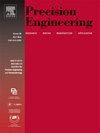Study on ultrasonic-assisted scratching and mirror grinding of silicon carbide based on truncated coarse diamond wheel
IF 3.5
2区 工程技术
Q2 ENGINEERING, MANUFACTURING
Precision Engineering-Journal of the International Societies for Precision Engineering and Nanotechnology
Pub Date : 2025-02-14
DOI:10.1016/j.precisioneng.2025.02.012
引用次数: 0
Abstract
Ultrasonic vibration-assisted grinding (UVAG) has been proven to be an effective method for processing hard and brittle materials such as silicon carbide (SiC). However, most UVAG processes use fine-grained diamond grinding wheels to achieve higher accuracy, which brings about the problems of heavy wear and frequent dressing, and lower material removal rates. Therefore, a new UVAG method based on coarse-grained diamond grinding wheel was proposed to realize mirror grinding of SiC. In this paper, the effects of ultrasonic power on the critical depth and grinding force were investigated during the brittle-ductile transition of SiC material removal. The effects of grinding process parameters and ultrasonic power on the ground surface quality were also analyzed and compared. The results show that the ductile removal region and the critical depth of brittle-ductile transition increase while the critical scratching force decreases when the ultrasonic power increase in a certain range. When the ultrasonic power is 40 % (ultrasonic amplitude of 2.36 μm), the longest ductile domain length, the largest critical brittle-ductile transition depth and the least critical scratching force of the scratched SiC surface reached 257.49 μm, 0.608 μm and 4.47 N, respectively. This indicates a significant positive impact of ultrasonic vibration on grinding of SiC. Compared with traditional mechanical grinding, coarse diamond grinding wheels assisted by ultrasonic vibration can achieve better surface quality, reducing the surface roughness of SiC by approximately 65.38 %. The surface roughness reaches the minimum value of 36 nm at the wheel speed of 12000 r/min, feed rate of 20 mm/min, grinding depth of 2 μm, and ultrasonic power of 40 %, resulting in a mirror-like macroscopic surface.
求助全文
约1分钟内获得全文
求助全文
来源期刊
CiteScore
7.40
自引率
5.60%
发文量
177
审稿时长
46 days
期刊介绍:
Precision Engineering - Journal of the International Societies for Precision Engineering and Nanotechnology is devoted to the multidisciplinary study and practice of high accuracy engineering, metrology, and manufacturing. The journal takes an integrated approach to all subjects related to research, design, manufacture, performance validation, and application of high precision machines, instruments, and components, including fundamental and applied research and development in manufacturing processes, fabrication technology, and advanced measurement science. The scope includes precision-engineered systems and supporting metrology over the full range of length scales, from atom-based nanotechnology and advanced lithographic technology to large-scale systems, including optical and radio telescopes and macrometrology.

 求助内容:
求助内容: 应助结果提醒方式:
应助结果提醒方式:


